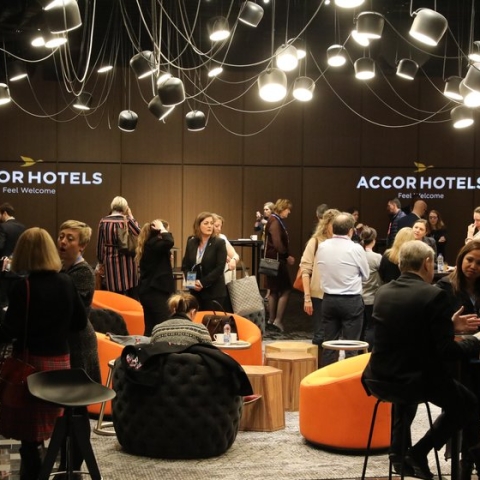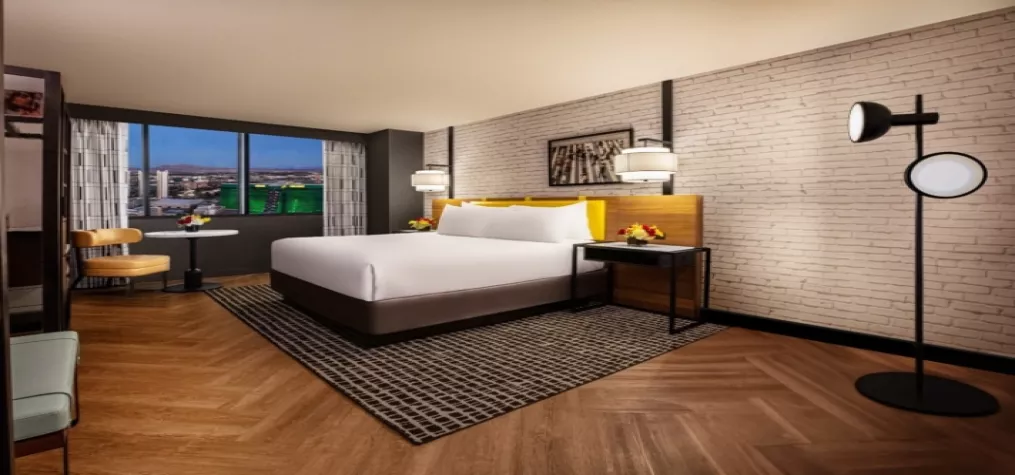AccorHotels: a Growing Presence in North America

When a top leader makes his grand entrance to Walk the Moon’s “Shut Up and Dance with Me,” you know it’s going to be a fun conference. Indeed, Chris Cahill, CEO of luxury brands for AccorHotels, set the stage for a creative four days of meetings, talks and workshops at the brand’s seventh annual Global Meetings Exchange (GME), held Feb. 28-Mar. 3 in Montreal.
It was the first time the event has been held in North America, and to some meeting planners and media in attendance, their first in-depth exposure to the brand. Meetings managers who primarily coordinate domestic events may be surprised to learn AccorHotels has 4,300 hotels across 100 countries. AccorHotels properties are heavily concentrated in Europe and South Asia, as well as South America and Australia. Only two percent of its properties (83 hotels) are in North America.
The company was started in 1967 with the opening of the first Novotel in France. In 1980, it took over the four-star brand Sofitel, and in 2007 launched the upscale business brand Pullman. It wasn’t until summer 2016 that AccorHotels got serious about luxury, acquiring Fairmont, Raffles and Swissotel in its quest to become a global player in the upper upscale hotel market.
Less than two years later, Fairmont has become an anchor brand for AccorHotels, most notably with the opening of the 1,048-room Fairmont Austin in March. With the country still experiencing greater demand for large convention hotels than supply, it’s no surprise the Austin property—which has nearly 140,000 square feet of meeting space—had already sold more than 100,000 room nights a year and a half out from opening.
Other Fairmont properties provide ample meeting spaces in addition to unique experiences for MICE groups. At Fairmont Waterfront in Vancouver, book a hands-on package with the hotel beekeeper; at Fairmont Jasper Park Lodge in Alberta, check in via canoes and arrange a cabin-crawl dinner. The Fairmont Orchid in Hawaii offers “flo-yo” (floating yoga) as a teambuilding activity; while Fairmont Banff Springs, the largest conference resort in Canada, can host dinners for up to 1,000 at long tables overlooking the Rocky Mountains. The Fairmont Scottsdale Princess in Arizona, which has a meeting room staged to look like an authentic Western town set, is a popular spot for groups of up to 750. In Sonoma, California, Fairmont Sonoma Mission Inn & Spa is adding an Airstream gourmet food truck to its F&B offerings this year. And later in 2018, the former Century Plaza Hotel in Los Angeles will reopen as Fairmont Century Plaza.
Fairmont Queen Elizabeth, where GME was held, is perhaps the most innovative Fairmont property of all when it comes to creative spaces. Emerging last summer from a top-to-bottom, $140 million renovation, the historic hotel debuted an immersive business campus (in partnership with the C2 conference) with 13 meeting rooms and seven themed meeting spaces, including a room with swings, a Ping-Pong table that doubles as a meeting table and a room with wraparound digital walls designed to look like a living aquarium.
“The experiential meeting space here has been booked more than we expected,” says Cahill of the property, noting how the growing personal nature of luxury is spilling into the events world. “Leisure travelers want to be transformed by travel, and now that’s also in meetings.”
Pullman is another AccorHotels brand that may be relatively unfamiliar to American meeting planners. There are currently only two Pullman properties in the United States (an airport hotel in Miami, and one in San Francisco), but the brand has a strong presence in other parts of the world, particularly in Europe and Australia. This fast-growing, meetings-focused brand hosts more than 30,000 events every year.
Chicago is the only city in the U.S. to have a Fairmont, a Swissotel and a Sofitel. It’s one of the first markets to test Swissotel’s new Vitality room concept, designed to help guests maintain their health and well-being on the road. The rooms feature a calm color palette, blackout blinds, discreet technology, and dedicated spaces for exercise and relaxation, plus circadian lighting options in the bath and shower and a high-performance air purification system.
“We’ll be putting these into more of our hotels; we’re just not sure how many,” said Cahill of the Vitality rooms during a roundtable discussion at GME.
The French-influenced Sofitel brand brings Parisian elegance and practicality to every element of its six hotels in the U.S., from the cuisine to the décor and even the Parisian bartenders. In many respects, it was ahead of its time when it comes to trends in hotels and meetings. For example, the recently renovated Sofitel Magnificent Mile in Chicago launched the concept of a living-room-style lobby back in 2002 when it first opened, a concept introduced in hotels around the world only in the last few years. And through its Magnifique Meetings program, Sofitel has been creating healthy F&B breaks for meetings and events since 2011, way before smoothie and juice stations, clever takes on fruits and vegetables, and allergy-friendly items became the near norm.
While Raffles properties don’t typically have large meeting spaces, they can be a good choice for smaller incentive groups. The Banyan Tree brand, which includes 43 luxury resorts around the world, is another popular option for incentives that have a meeting component.
Still, AccorHotels as a whole is very focused on growing its meetings business—which is less sensitive to economic shifts than leisure tourism—even during a time when leisure demand is near an all-time high, with tools like a dedicated meetings website in addition to the aforementioned innovations and amenities.
“We’re in the golden age of travel to an extent,” said Cahill during his opening remarks at GME. “We’re anticipating pace of change and how to get ahead of it, and we’re currently very bullish.”
As GME took place only a few weeks after Marriott’s scandalous announcement that the company would reduce third-party planners’ commission from 10 percent to 7 percent, the planners in the audience were relived to hear Cahill address the issue head-on: AccorHotels will not follow suit, at least for now, he said.
Jeff Doane, senior vice president of sales and marketing for North and Central America, affirmed that position. “Hilton will follow, then Hyatt, then it might become an industry standard,” he says. “We’ll see.”


Add new comment